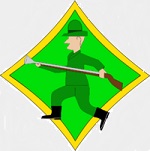Corgi AA34908 German Messerschmitt Bf 109G-6 Fighter - Maj. Hermann Graf, "Red 1," Gruppenkommandeur Jagdgeschwader 50, Wiesbaden-Erbenheim, 1943 (1:32 Scale)
"Guns before butter. Guns will make us powerful; butter will only make us fat."
- Reichsmarschall Hermann Goering, Head of the German Luftwaffe
 Numerically the most abundant fighter produced by either side during WWII, the Messerschmitt Bf 109 formed the backbone of the Jagdwaffe on both the eastern and western fronts, as well as in the Mediterranean and North Africa. Of the eight distinct sub-types within the huge Bf 109 family, the most populous was the G-model, of which over 30,000 were built between 1941-45. Despite its production run, only a handful of genuine German Bf 109s have survived into the 1990s, and with the serious damaging of the RAFs G-2 at Duxford in October 1997, only the German-based MBB G-6 and Hans Ditte's G-10 (both composites) are currently airworthy. This particular Messerschmitt Bf 109G-2 fighter was flown by Oberleutnant Heinrich Ehrle, Staffelkapitan of 6./JGS5, when it was based at Petsamo, Finland in 1943.
Numerically the most abundant fighter produced by either side during WWII, the Messerschmitt Bf 109 formed the backbone of the Jagdwaffe on both the eastern and western fronts, as well as in the Mediterranean and North Africa. Of the eight distinct sub-types within the huge Bf 109 family, the most populous was the G-model, of which over 30,000 were built between 1941-45. Despite its production run, only a handful of genuine German Bf 109s have survived into the 1990s, and with the serious damaging of the RAFs G-2 at Duxford in October 1997, only the German-based MBB G-6 and Hans Ditte's G-10 (both composites) are currently airworthy. This particular Messerschmitt Bf 109G-2 fighter was flown by Oberleutnant Heinrich Ehrle, Staffelkapitan of 6./JGS5, when it was based at Petsamo, Finland in 1943.
Corgi's 1:32 scale Messerschmitt features exceptional levels of intricate detail including; removable engine covers with fully detailed engine, opening cockpit canopy with detailed pilot figure, removable gun covers with fitted machine guns and ammunition, moving flaps, rudder, ailerons and elevators, fully retractable undercarriage, rotating propeller and cradle display stand.
Sold Out!
Dimensions:
Wingspan: 12-1/4-inches
Length: 11-1/4-inches
Release Date: August 2010
 Historical Account: "Football" - Colonel Hermann Graf was a German Luftwaffe World War II fighter ace. During the war he became one of only 27 people to be awarded the Knight's Cross with leaves, swords, and diamonds. He served on both the Eastern and Western Fronts. He is credited with 212 victories, 202 of which were on the Eastern Front. First to achieve 200 aerial victories. He flew more than 830 sorties.
Historical Account: "Football" - Colonel Hermann Graf was a German Luftwaffe World War II fighter ace. During the war he became one of only 27 people to be awarded the Knight's Cross with leaves, swords, and diamonds. He served on both the Eastern and Western Fronts. He is credited with 212 victories, 202 of which were on the Eastern Front. First to achieve 200 aerial victories. He flew more than 830 sorties.
In 1943, Graf used his fame and influence to intervene to save all the best German soccer players from front-line service, having them transferred into JGr 50, under the pretext that they were "badly needed technical experts". These included Fritz Walter, future captain of the West German World Cup winning team in 1954. Walter was the star in Graf's own soccer team, following Graf from JGr 50 to JG 1, JG 11, and JG 52.
During this assignment Graf shot down three more enemy aircraft, including two B-17 Flying Fortress bombers. In October the unit was disbanded by Goring and absorbed into I./JG 301, and Graf was promoted to Oberst and appointed Geschwaderkommodore of JG 11 on November 11th. JG 11 was tasked with Reichsverteidigung (Defense of the Reich), and despite officially being banned from flying operational missions Graf managed to down 6 more aircraft over the next four months.
On March 29th, 1944, Graf shot down one P-51 Mustang and in the confusion of the dog fight collided with another. He managed to bail out, but was injured and had to spend some time in a hospital. After recovering he was appointed Kommodore of his old unit JG 52 on October 1st, which was still operating on the Eastern Front. With German forces in retreat by this time Graf did not have opportunity for air combat. He managed to bring his tally to 212 before he surrendered to the Americans on May 8th, 1945. Graf had disobeyed an order from General Hans Seidemann. Seidemann had ordered him and Erich Hartmann to fly to the British sector, to avoid capture by the Russians, with the rest of the wing surrendering to the Soviets. Instead Graf chose to surrender his unit to the 90th US Infantry Division.
Of his 212 victories, 10 were achieved in the West, and 6 of these were against heavy bombers.


